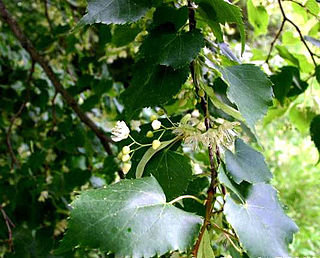
Tilia is a genus of about 30 species of trees or bushes, native throughout most of the temperate Northern Hemisphere. In the British Isles, they are commonly called lime trees, or lime bushes, although they are not closely related to the tree that produces the lime fruit. Other names include linden for the European species, and basswood for North American species. The genus occurs in Europe and eastern North America, but the greatest species diversity is found in Asia. Under the Cronquist classification system, this genus was placed in the family Tiliaceae, but genetic research summarised by the Angiosperm Phylogeny Group has resulted in the incorporation of this genus, and of most of the previous family, into the Malvaceae.

Tilia cordata is a species of Tilia native to much of Europe. It is found from Britain through mainland Europe to the Caucasus and western Asia. In the south of its range it is restricted to high elevations.

Houttuynia cordata, also known as fish mint, fish leaf, rainbow plant, chameleon plant, heart leaf, fish wort, Chinese lizard tail, or bishop's weed, is one of two species in the genus Houttuynia. It is a flowering plant native to Southeast Asia. It grows in moist, shady locations.

Nectandra is a genus of plant in the family Lauraceae found in South America, and having fruit with various medical effects. Sweetwood is a common name for some plants in this genus.
Nectandra barbellata is a species of plant in the family Lauraceae. It is endemic to Brazil. It is threatened by habitat loss.
Nectandra bicolor is a species of plant in the family Lauraceae. It is endemic to Panama. It is threatened by habitat loss.
Nectandra brochidodroma is a species of plant in the family Lauraceae. It is endemic to Peru. It is threatened by habitat loss.
Nectandra cufodontisii is a species of plant in the family Lauraceae. It is found in Costa Rica, Nicaragua, and Panama.
Nectandra fulva is a species of plant in the family Lauraceae. It is endemic to Venezuela.
Nectandra grisea is a species of plant in the family Lauraceae. It is native to Brazil and Peru.
Nectandra japurensis is a species of plant in the family Lauraceae. It is found in Brazil and Peru.
Nectandra obtusata is a species of plant in the family Lauraceae. It is found in Bolivia, Peru, Colombia and Ecuador.
Nectandra paranaensis is a species of plant in the family Lauraceae.
Nectandra parviflora is a species of plant in the family Lauraceae. It is found in Ecuador and Peru.
Nectandra reflexa is a species of plant in the family Lauraceae. It is found in Ecuador and Peru.
Nectandra salicina is a species of plant in the family Lauraceae. It is found in Costa Rica and Panama.
Nectandra smithii is a species of plant in the family Lauraceae. It is found in Costa Rica and Panama.
Nectandra venulosa is a species of plant in the family Lauraceae. It is endemic to Brazil.
Cucurbita cordata is a species of flowering plant in the squash family. It is similar to Cucurbita californica, Cucurbita cylindrata, Cucurbita digitata, and Cucurbita palmata and all these species hybridize readily. These species form the only restricted xerophyte species group in the genus Cucurbita. Each member of this species group is native to the Southwestern United States and Northwestern Mexico where they are relatively uncommon. Each group member is found in hot, arid regions with low rainfall. They prefer soil that is loose, gravelly, and well-drained. C. cordata is found only in the vicinity of Bahía de los Ángeles, Baja California. Botanists Bemis and Whitaker suggest that C. cordata and C. cylindrata may be a case of sympatric speciation. The juvenile leaves of C. cylindrata, C. cordata, C. digitata, and C. palmata show a high degree of similarity, but their mature leaves are visibly different, as are their root structures. C. cordata fruits are gray green, striped, and round.
Cucurbita cylindrata is a species of flowering plant in the squash family. It is similar to Cucurbita californica, Cucurbita cordata, Cucurbita digitata, and Cucurbita palmata and all these species hybridize readily. These species form the only restricted xerophyte species group in the genus Cucurbita. Each member of this species group is native to the Southwestern United States and Northwestern Mexico where they are relatively uncommon. Each group member is found in hot, arid regions with low rainfall. They prefer soil that is loose, gravelly, and well-drained. C. cylindrata is found only in the middle portion of Baja California, mostly in Baja California Sur. Botanists Bemis and Whitaker suggest that C. cordata and C. cylindrata may be a case of sympatric speciation. The juvenile leaves of C. cylindrata, C. cordata, C. digitata, and C. palmata show a high degree of similarity, but their mature leaves are visibly different, as are their root structures. C. cylindrata fruits are dark green, striped, and round.




